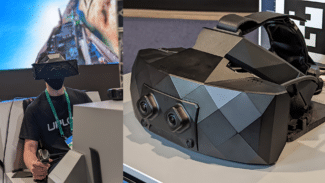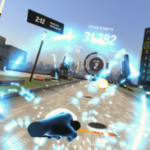XTAL 3 is the most immersive virtual reality headset I’ve ever worn.
Humans beings can, without eye rotation, see roughly 210° horizontally. Just over a decade ago, head mounted displays peaked at around 50° horizontal – any wider starts to introduce geometric distortion. An important innovation of Palmer Luckey’s original Oculus Rift prototypes – and a core reason for the Kickstarter campaign’s viral success – was the dramatic widening of the field of view to roughly 100° while still remaining affordable. This was achieved by correcting for the lenses’ pincushion distortion in software with a barrel distortion effect, so it cancels out to a stable image.
In the decade since, almost every VR headset has followed this same optical design pattern and offered roughly the same horizontal field of view, plus or minus 10°. The few exceptions were expensive enterprise-focused headsets such as XTAL’s previous models (~150°), and a startup with some past quality assurance and delivery issues called Pimax (~170°). But these exceptions all had a serious flaw – with most lens designs the field of view beyond around 120° has uncorrectable distortion. In practice, this means the virtual world warps in the periphery as you look around, like looking into a fish bowl or wearing a scuba mask.
Some people say they can accept this distortion, or at least that they prefer it to the somewhat claustrophobic feeling of mainstream headsets. But for me, the virtual world and the objects within it need to be geometrically consistent or the illusion of presence breaks. Back in 2014 at Steam Dev Days, Valve’s Michael Abrash (who soon after became Oculus Chief Scientist) noted the following: “optical calibration seems like a minor point, but has proven to be critical and hugely challenging, because the human visual system is astonishingly sensitive to slight errors […] this destroys presence and can induce motion sickness almost instantaneously”.
When I first arrived at XTAL’s CES booth I was placed into a demo running the popular DCS simulator (available on Steam). I was severely disappointed at first. While the field of view was impressive, the lens distortion was apparent in all but the very center. Upon taking the headset off, however, I was greeted by Vrgineers founder Marek Polcak, who had been on the other side of the booth. He explained that what I’d tried was actually the previous model, and quickly escorted me into a demo of XTAL 3.

As soon as I put on XTAL 3, I realized I was looking at a completely different lens design. Not only was the field of view actually wider, the distortion was gone. It is the most immersive VR headset I have ever used – and there is no close second. In case you’re wondering, both headsets felt comfortable to wear despite the comically large design.
So what’s the catch? Well, it’s the price of course. XTAL 3 is a $10,000 headset, intended for use in enterprise and public sector training such as flight simulation. But Polcak claims this price is more a function of the low-volume high-support current audience. He told me XTAL is currently in initial talks with mass market consumer electronics companies such as Razer with the eventual goal of a more affordable headset, which could sit at the high end of the consumer spectrum (or dare I say, “prosumer”).

Here are the specifications for XTAL 3, according to Vrgineers:
- Displays: 3840×2160 per eye fast-switch LCD
- Refresh Rate: 75Hz at 4K or 120Hz at 1440p
- Field of View: 180° horizontal × 90° vertical
- Weight: 600 grams without head strap
- Eye Tracking with foveated rendering and automatic IPD adjustment
- Platform: SteamVR or OpenXR
VR enthusiasts have been longing for ultra wide field of view for years. HTC has widened its lenses only slightly and the field of view of Meta headsets has stagnated. Peripheral vision is crucial to feeling truly present in a virtual space, and XTAL 3 is the first to get it right. But the question remains: exactly how long will it take for consumers get this too?







